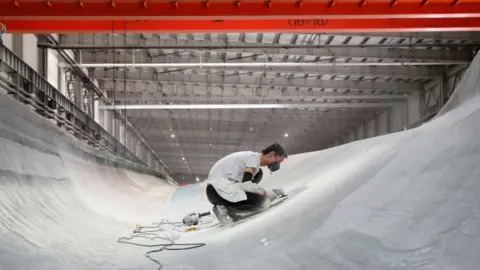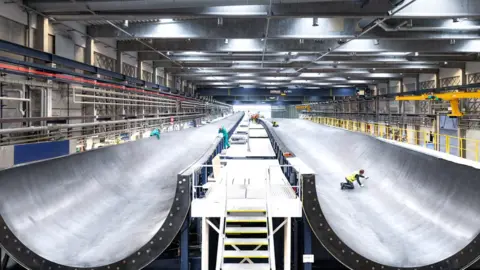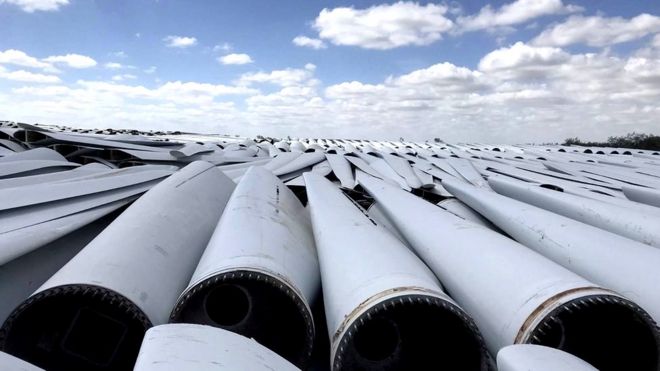Οι ανεμογεννήτριες καταλήγουν σε χωματερές γιατί δεν ανακυκλώνονται
When wind turbine blades get old what's next?
By Michael Winrow,Technology of Business reporter, στο https://www.bbc.IwAR35kOwtJxz205OkTZOGWU12IvEPNN6NUs0TURU__bRvX617uNdavL4DKpk

ScottishPower Renewables -The old wind turbines at Hagshaw Hill wind farm in Scotland have been dismantled
The cranes moved in last year at Hagshaw Hill, Scotland's oldest commercial wind farm.
They were there to continue the dismantling of wind turbines that had been generating electricity for the last 28 years.
A similar scene can be witnessed across the world as the first wave of wind turbines built in the late 1990s and early 2000s are decommissioned.
In the case of Hagshaw Hill, the existing turbines will be replaced with taller and more efficient ones that can generate up to 10 times more electricity.
But working out what to do with the old turbines is challenging.
Between 85 and 95% of a turbine's materials, such as steel, aluminium, and copper, can be easily recycled, but the blades are a different matter.
Made of fibreglass they are covered with a tough epoxy resin, designed to withstand years of hammering by the elements.
These durable qualities make breaking down the blades for recycling a tricky process.

Traditional solutions include using pieces of decommissioned blades in cement kilns to manufacture cement, though this can be an energy intensive process.
Blades are also commonly disposed of in landfill sites, but this option is becoming increasingly less feasible with a number of countries, notably Germany and the Netherlands, banning the practice.
Innovative solutions such as repurposing blades into playgrounds or bike sheds have been shown to be effective at a local level but, with some experts predicting up to 43 million tonnes of wind turbine blade waste by 2050, there is a pressing need for a system that will work on a bigger scale.
Scientists and start-ups are working on the problem, with many focusing on tackling the challenge of breaking down the materials used in the blades.
"At the end of life, if we're going to get any value out of the materials, we need to be able to separate the fibres from the resin in some way or another," Dr Claire Barlow, a sustainability and materials engineer, from the University of Cambridge tells me.
One approach showing promise uses a technique developed by the University of Strathclyde.
It involves breaking the blades down into small pieces and feeding them into a very hot air stream.
The process separates the glass fibre from the resin. The glass fibre can then be collected, treated and reused, explains Malcolm Forsyth who leads Project PRoGrESS, which aims to commercialise the technology.
The project, which kicked off in 2022, is working on a pilot plant that's due to be operational in the first half of this year - though it's hit some difficulties.
"The major challenge for the project team has been the rapid escalation of material costs partly due to the Russia and Ukraine war, as well as global inflation," according to Mr Forsyth.
Similar solutions are being tested elsewhere that use different methodologies but have the same overarching goal of breaking down the materials used in wind turbine blades.

Danish company Vestas, the largest wind turbine producer in Europe, announced last year an approach that uses a liquid chemical solution to break down the blades into materials which can then potentially be used to make new blades.
A major advantage of this approach, according to Vestas, is that it uses widely available chemicals, though details haven't been disclosed. The process has the added benefit of not requiring energy-intensive high temperatures.
Both of these traits hint at potential scalability, with the company claiming to have recycled 475 end-of-life blades in 2022.
If technologies such as these succeed "then not only can we solve the problem of new waste coming through, but we can also actually tackle historic waste," according to Dr Barlow.
Historic blade waste currently in landfill could be recycled, as could waste which has been placed in storage awaiting a solution.
At Hagshaw Hill a number of wind turbines have been kept in storage while ScottishPower Renewables decides what to do with them.
Perhaps the future will be to make turbine blades that are easier to break down.
A number of companies are working on building blades made out of materials less reliant on the difficult to recycle fibreglass and epoxy resin. However at this stage, the vast majority of blades continue to be made of these traditional materials.
The next few years will determine whether the recycling technology under development can be scaled-up to a useful size, without harming the environment.
As Dr Barlow puts it "that really is the silver bullet."
Τάσος Σαραντής
πηγή:https://www.efsyn.gr/kosmos/maties-ston-kosmo/oikologika/230663_nea-pligi-oi-gerasmenes-anemogennitries
Ανανεώσιμη ενέργεια με μη ανακυκλώσιμα υλικά
Τελικά, η παγκόσμια βιομηχανία των αιολικών δεν μας τα είχε πει όλα όταν υποσχόταν ότι η αιολική ενέργεια θα συμβάλει στη σωτηρία του πλανήτη, καθώς είχε παραλείψει να αναφέρει πως αυτή η «ανανεώσιμη» πηγή ενέργειας θα παράγει μια τεράστια ποσότητα μη ανακυκλώσιμων αποβλήτων που θα καταλήξει στους ξηρούς τάφους των χωματερών!
Σαν να μην είχε σκεφτεί το λόμπι των αιολικών το τι θα απογίνει η τεράστια ποσότητα των πτερυγίων των ανεμογεννητριών μόλις φτάσουν στο τέλος της ζωής τους. Και ότι η κερδοφορία από τις επενδύσεις του σε αυτή τη μορφή της «πράσινης» κατά τα λοιπά ενέργειας θα προκαλέσει την απόρριψη χιλιάδων τόνων μη ανακυκλώσιμων πτερυγίων σε χώρους υγειονομικής ταφής της χώρας.
Πρόκειται για ένα τεράστιο, «αναπάντεχο» οικολογικό πρόβλημα που έχει αρχίσει να ανακύπτει ήδη στις χώρες που έχουν αδειοδοτήσει τη λειτουργία χιλιάδων αιολικών και θα βρεθεί μπροστά σε όσες χώρες επενδύουν στα αιολικά σήμερα. Κι αυτό γιατί ο αριθμός των πτερυγίων των ανεμογεννητριών ανά τον κόσμο προβλέπεται να τετραπλασιαστεί τα επόμενα δεκαπέντε χρόνια, καθώς πολύ περισσότερα από αυτά ολοκληρώνουν τη ζωή τους που, σύμφωνα με τη βιομηχανία των αιολικών, διαρκεί 15 έως 20 χρόνια. Ενας αμφισβητήσιμος ισχυρισμός, αφού μια μελέτη του 2012 από το Renewable Energy Foundation στη σχετικά ώριμη ολλανδική και βρετανική βιομηχανία των αιολικών διαπίστωσε ότι μόνο μερικά από τα αιολικά πάρκα θα λειτουργούν για περισσότερα από 12 έως 15 χρόνια. Επιπλέον, το μέγεθος και το μήκος των νεοεισαχθέντων πτερυγίων των ανεμογεννητριών είναι τώρα διπλάσιο από αυτό που ήταν πριν από 20-30 χρόνια φτάνοντας ακόμη και τα 90 μέτρα περίπου.
Ηδη, δεκάδες χιλιάδες γερασμένα πτερύγια ανεμογεννητριών κατεβαίνουν από τους πύργους χάλυβα όπου δέσποζαν σε όλο τον κόσμο. Μόνο στις ΗΠΑ, περίπου 32.000 θα αφαιρεθούν στα επόμενα τέσσερα χρόνια, ενώ στην Ευρώπη ο αντίστοιχος αριθμός ξεπερνάει τα 15.000. Αλλά το πρόβλημα θα επιδεινωθεί καθώς αυτά τα πτερύγια προέρχονται από ανεμογεννήτριες που κατασκευάστηκαν περισσότερο από μία δεκαετία πριν, όταν οι ο αριθμός των εγκατεστημένων αιολικών ήταν λιγότερο από το ένα πέμπτο από ό,τι είναι σήμερα.
Ασύμφορο
Γιατί η βιομηχανία αιολικής ενέργειας πρέπει να απορρίπτει τα πτερύγιά της σε χώρους υγειονομικής ταφής; Δυστυχώς, εξαιτίας του τρόπου κατασκευής των πτερυγίων, δεν συμφέρει οικονομικά ή πρακτικά να ανακυκλώνονται - σε αντίθεση με τον χάλυβα και τον χαλκό, υλικά από τα οποία κατασκευάζεται κυρίως το υπόλοιπο τμήμα της πλειονότητας των ανεμογεννητριών.
Κατασκευασμένα για να αντέχουν στους ισχυρούς ανέμους, τα πτερύγια των ανεμογεννητριών είναι ένα τοξικό κράμα μοναδικών σύνθετων υλικών, με κυριότερο το φάιμπεργκλας (υαλόνημα) που δεν μπορεί εύκολα να θρυμματιστεί, να ανακυκλωθεί ή να επαναχρησιμοποιηθεί. Και, παρ’ όλο που υπάρχουν λίγα μικρά κέντρα ανακύκλωσης για πτερύγια ανεμογεννητριών, δεν είναι οικονομικό να ανακυκλωθούν σε μεγάλη κλίμακα.
Σύμφωνα με εκτιμήσεις, η βιομηχανία της αιολικής ενέργειας θα παραγάγει 50.000 τόνους πτερυγίων ως απόβλητα έως το 2020, ποσότητα που θα τετραπλασιαστεί και θα ανέλθει σε 225.000 τόνους μέχρι το 2034. Αυτός ο όγκος θα καταλάβει σημαντικό χώρο στις ήδη κορεσμένες χωματερές ταφής αποβλήτων του πλανήτη, αν ληφθεί υπόψη ότι κάθε πτερύγιο χρειάζεται μεταξύ 30 και 44,8 κυβικών μέτρων χώρο στους χώρους υγειονομικής ταφής. Και η αποσυναρμολόγηση απαιτεί πολύ χρόνο και ενέργεια.
Λόγω του μεγέθους και του βάρους τους, τα ολοένα και πιο μεγάλα πτερύγια πρέπει να κοπούν πριν μετακινηθούν, με το κόστος μεταφοράς να καθίσταται απαγορευτικό για μεγάλες αποστάσεις. Λόγος για τον οποίο τα νεκροταφεία των πτερυγίων των ανεμογεννητριών βρίσκονται συνήθως στις γειτονικές με τις ογκώδεις ανεμογεννήτριες περιοχές που πρότερα έμεναν ικανοποιημένες, εφόσον και εάν έπαιρναν κάποιο αμυδρό αντισταθμιστικό όφελος από την εγκατάστασή τους στα εδάφη τους.
«Τα πτερύγια των ανεμογεννητριών στο τέλος της λειτουργικής τους ζωής είναι ασφαλή σε χώρους υγειονομικής ταφής, σε αντίθεση με τα απόβλητα από ορισμένες άλλες πηγές ενέργειας και αντιπροσωπεύουν ένα μικρό κλάσμα των συνολικών αστικών στερεών αποβλήτων των ΗΠΑ», δηλώνει απαντώντας στις επικρίσεις η Αμερικανική Ενωση Αιολικής Ενέργειας και υποστηρίζει ότι πρόκειται για μια λύση που είναι ασφαλέστερη και φτηνότερη.
Η πολυεθνική εταιρεία Veolia, αναζητώντας εναλλακτικές δυνατότητες διάθεσης των πτερυγίων των ανεμογεννητριών, διαπίστωσε ότι τα παροπλισμένα πτερύγια μπορούν να θρυμματιστούν και να καούν μαζί με άλλα εξαρτήματα στους κλιβάνους των τιμεντοβιομηχανιών. Μέσω αυτής της διαδικασίας, τα πτερύγια μετατρέπονται σε στερεό καύσιμο που μπορεί να χρησιμοποιηθεί στη βιομηχανία τσιμέντου και να αντικαταστήσει τα παραδοσιακά ορυκτά καύσιμα.
Ηδη, στην Ευρωπαϊκή Ενωση, η οποία θεωρητικά έχει αυστηρό νομοθετικό πλαίσιο για τα υλικά που μπορούν να εισέλθουν σε χώρους υγειονομικής ταφής, κάποια καίγονται σε κλιβάνους που δημιουργούν τσιμέντο ή σε σταθμούς ηλεκτροπαραγωγής, παρ’ όλο που αυτή η διαδικασία παράγει επικίνδυνους για την υγεία τοξικούς ρύπους. Και αυτό διότι -κατά έναν παράδοξο τρόπο- η Ευρωπαϊκή Ενωση εντάσσει μέσα στο πλαίσιο της ανακύκλωσης και της αποκαλούμενης «κυκλικής οικονομίας» την καύση αποβλήτων για την παραγωγή ενέργειας.
Σχετικά άρθρα:
Wind Turbine Blades Can’t Be Recycled, So They’re Piling Up in Landfills
από το οποίο έχει αντλήσει και η ΕφΣυντ στοιχεία. Φωτογραφίες από το άρθρο αυτό πιο κάτω:





---
What happens to all the old wind turbines?
By Padraig Belton Technology of Business reporter, 7 February 2020, από το https://www.bbc.com/news/business-51325101
Τurbines from the 1990s are reaching the end of their working lives
Welcome to the wind turbine graveyard. It stretches a hundred metres from a bend in the North Platte River in Casper, Wyoming.
Between last September and this March, it will become the final resting place for 1,000 fibreglass turbine blades.
These blades, which have reached the end of their 25-year working lives, come from three wind farms in the north-western US state. Each will be cut into three, then the pieces will be stacked and buried.
Turbines from the first great 1990s wave of wind power are reaching the end of their life expectancy today. About two gigawatts worth of turbines will be refitted in 2019 and 2020. And disposing of them in an environmentally-friendly way is a growing problem. Image copyright Global Fibreglass Solutions Image caption Many unwanted blades are just buried
Burying them doesn't sound very green. Can they not be recycled?
Wind power goes as far back at least as 9th Century BC Persia, where sails were used to grind grain and draw up water on the windy Sistan plains.
Scottish professor James Blyth built the first windmill to make electricity in 1887, powering his holiday home in Marykirk.
His second powered the Lunatic Asylum, Infirmary and Dispensary in Montrose (later Sunnyside Royal Hospital).
Instead of using cloth to catch the wind like Prof Blyth and the ancient Iranians, today's turbine blades are built from composite materials - older blades from glass fibre, newer ones from carbon fibre.
Such composite materials might be light and strong, but they are also extremely hard to recycle. Image copyright Global Fibreglass Solutions Image caption Don Lilly of Global Fiberglass Solutions hopes to sell pellets made from recycled turbine blades
That doesn't mean they have to go into landfill, according to Don Lilly, chief executive of Global Fiberglass Solutions in Bellevue, Washington.
Mr Lilly has been transforming fibreglass composites into small pellets he calls EcoPoly.
The pellets can then be turned into injectable plastics, or highly waterproof boards that can be used in construction, he says.
Mr Lilly has received interest from "several manufacturers" for his pellets.
He's also developed a programme to track blades throughout their life cycle, and make it easier to recycle them at the end. Image copyright Global Fibreglass Solutions Image caption Pellets made from old turbine blades can be used to make new products
If we "holistically think about the end of life, there are simple choices we could make now that could make fibreglass in the blade easier to recycle," says Richard Cochrane, professor of renewable energy at Exeter University.
A second avenue for recycling turbine blades is called pyrolysis.
After first chopping up the blades, pyrolysis breaks up the composite fibres in ovens with an inert atmosphere, at about 450-700C.
The process recovers fibres other industries can reuse for glues, paints, and concrete.
Other products include syngas (synthesis gas) that can be used in combustion engines. And char (charcoal) which can be used as a fertiliser.







Σχόλια
Δημοσίευση σχολίου